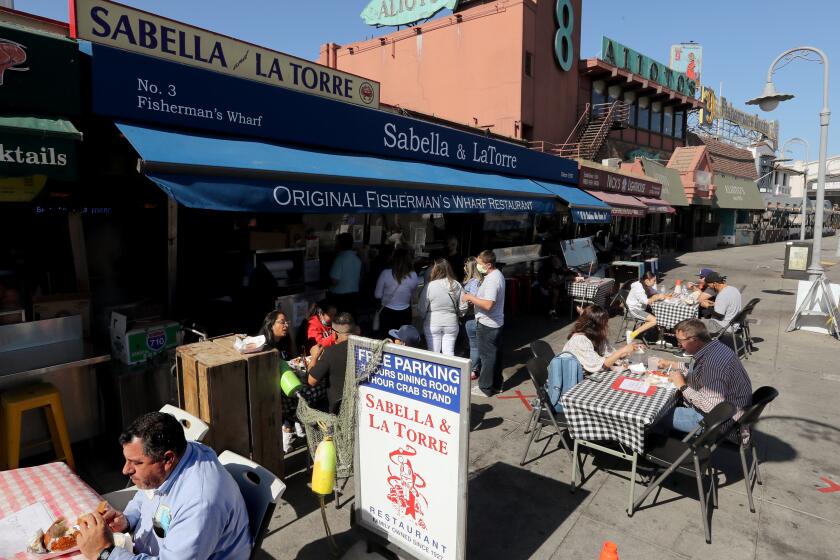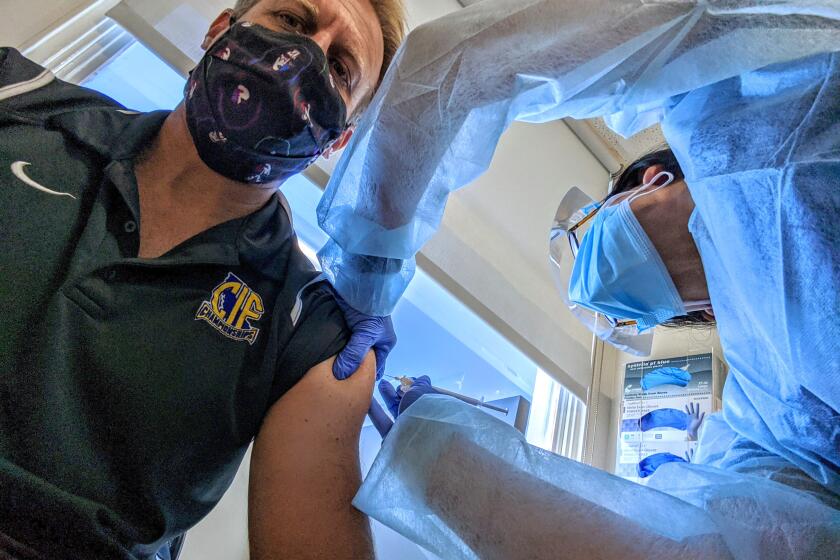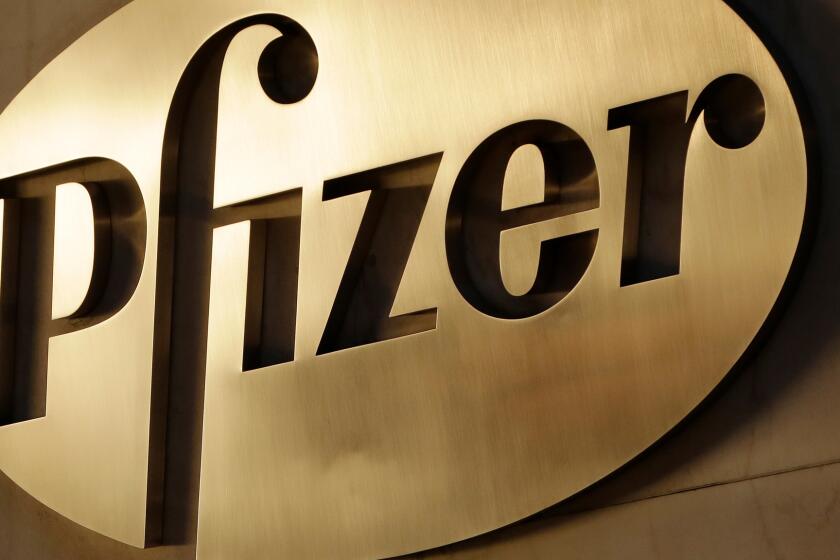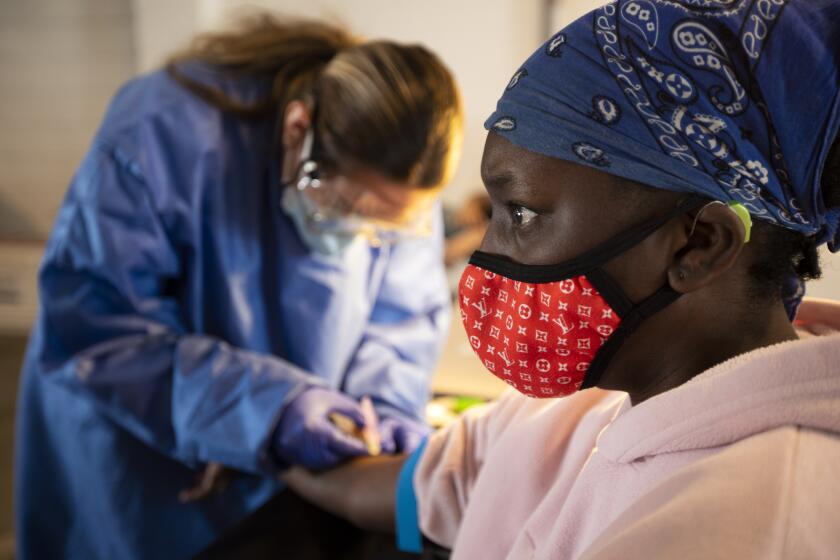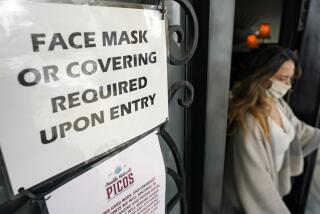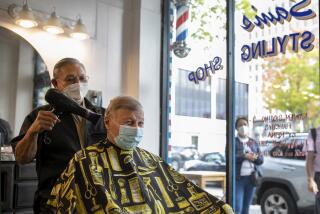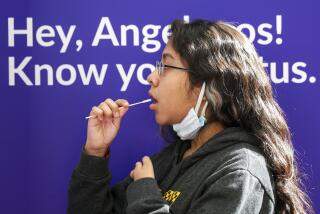U.S. hits record high number of COVID-19 hospitalizations
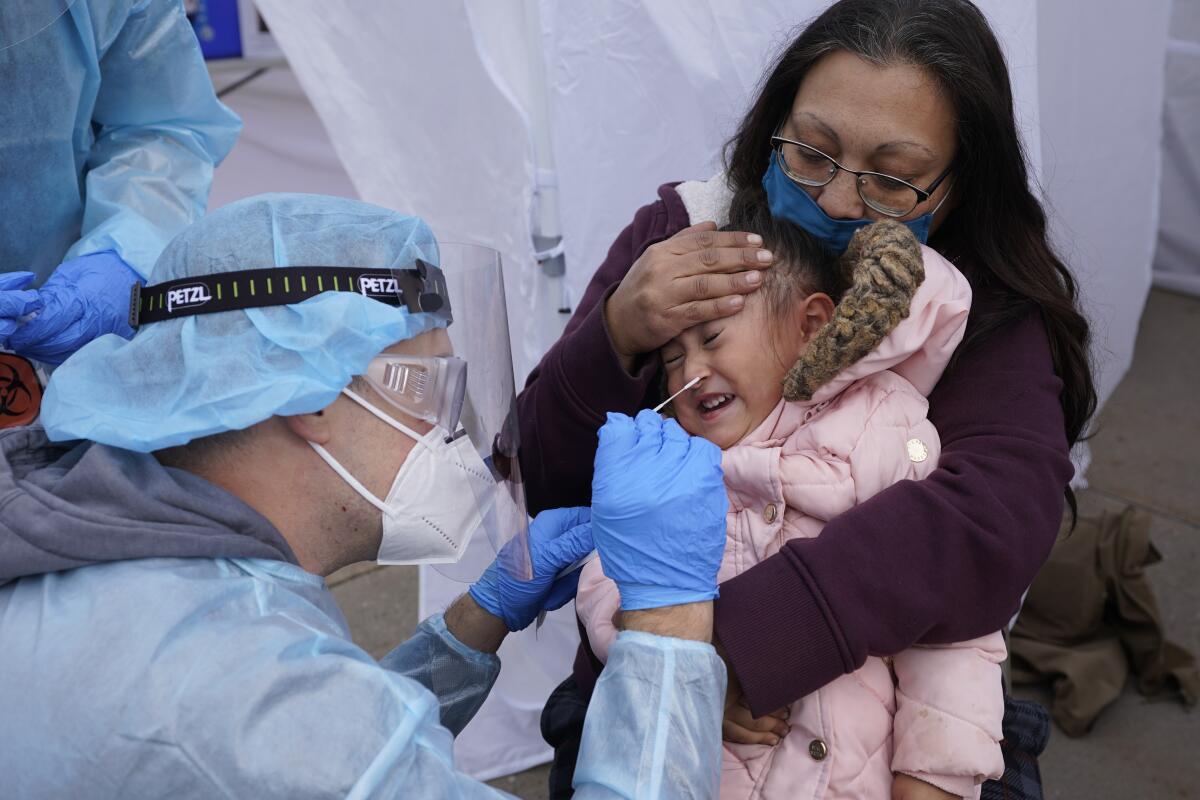
- Share via
NEW YORK — The U.S. hit a record number of COVID-19 hospitalizations Tuesday and surpassed 1 million new confirmed coronavirus cases in just the first 10 days of November amid a nationwide surge of infections that shows no signs of slowing.
The new wave appears bigger and more widespread than the surges in the spring and summer — and threatens to be worse. But experts say there are also reasons to think the nation is better able to deal with the situation this time around.
“We’re definitely in a better place” when it comes to improved medical tools and knowledge, said William Hanage, a Harvard University infectious-disease researcher.
Newly confirmed infections in the U.S. were running at all-time highs of well over 100,000 per day, pushing the total to more than 10 million and eclipsing 1 million since Halloween. There are now 61,964 people hospitalized, according to the COVID Tracking Project.
Several states posted records Tuesday, including more than 12,600 new cases in Illinois, 10,800 in Texas — which has now surpassed 1 million cases overall — and 7,000 in Wisconsin.
Deaths are climbing again, reaching an average of more than 930 a day.
Los Angeles County Department of Public Health Director Barbara Ferrer expressed optimism about early indications that Pfizer vaccine is 90% effective, but urged residents to “stay the course” as cases surge.
Hospitals are getting slammed. And unlike the earlier outbreaks, this one is not confined to a region or two.
“The virus is spreading in a largely uncontrolled fashion across the vast majority of the country,” said Dr. William Schaffner, an infectious-disease expert at Vanderbilt University.
Governors made increasingly desperate pleas for people to take the fight against the virus more seriously.
In an unusual prime-time speech hours after Wisconsin set new records for infections and deaths, Democratic Gov. Tony Evers announced that he was advising people to stay in their houses and asking businesses to allow people to work remotely, require masks and limit the number of people in stores and offices.
San Francisco is halting indoor dining again, reducing capacity at gyms and theaters, but is allowing many schools to remain open -- for now.
Minnesota Gov. Tim Walz, a Democrat, ordered bars and restaurants to close at 10 p.m., and Iowa Gov. Kim Reynolds, a Republican, said she would require masks at indoor gatherings of 25 or more people, inching toward more stringent measures after months of holding out.
While deaths are still well below the U.S. peak of about 2,200 per day back in April, some researchers estimate the nation’s overall toll will hit about 400,000 by Feb. 1, up from about 240,000 now.
But there is also some good news.
Doctors now know more in treating severe cases, meaning that a higher proportion of COVID-19 patients who go into intensive care are coming out alive. Patients have the benefit of new treatments such as remdesivir, the steroid dexamethasone and an antibody drug that won emergency-use approval from the Food and Drug Administration on Monday. Also, testing is more widely available.
In addition, a vaccine appears to be on the horizon, perhaps around the end of the year, with Pfizer this week reporting promising early results that show its experimental shots to be 90% effective at preventing the disease.
Father and daughter partook in a vaccine trial at Kaiser hospital. On Monday, Pfizer announced its success
And there’s a change pending in the White House, with President-elect Joe Biden vowing to rely on a highly respected set of medical advisors and carry out a detailed coronavirus battle plan that experts say includes the kind of measures necessary to bring the surge under greater control.
Biden pledged during the campaign to be guided by science, make testing free and widely available, hire thousands of healthcare workers to undertake contact-tracing and instruct the Centers for Disease Control and Prevention to provide clear, expert advice.
“We are already seeing encouraging signs from President-elect Biden with regard to his handling of COVID-19,” said Dr. Kelly Henning, a veteran epidemiologist who heads the Bloomberg Philanthropies’ public health programs.
“I am relieved to see he’s already put some of the smartest scientific minds on his new coronavirus task force and that they are acting urgently to try and get the pandemic under control as quickly as possible,” Henning said.
Lots more needs to be known about the Pfizer vaccine before COVID-19 is beaten.
While the first surge in the Northeast caught many Americans unprepared and cut an especially deadly swath through nursing homes, the second crest along the nation’s Southern and Western rim was attributed mostly to heedless behavior, particularly among young adults over the Memorial Day and Fourth of July holidays, and hot weather that sent people indoors, where the virus spreads more easily.
The fall surge similarly has been blamed largely on cold weather driving people inside, as well as a disdain for masks and social distancing stoked by President Trump and other politicians.
Even in parts of the country that have been through coronavirus surges before, “you see people breaking out of it” and letting their guard down, Schaffner said.
“There really is COVID fatigue that is blending into COVID annoyance,” he said.
In the unprecedented regression, San Diego County is among those that slide backward in the state’s reopening tiers Tuesday.
The short-term outlook is grim, with colder weather and Thanksgiving, Christmas and New Year’s ahead. Generations of family members gathering indoors for meals for extended periods “is not a recipe for anything good,” Hanage said.
Other factors could contribute to a rise in cases in the coming weeks. Last weekend saw big street celebrations and protests over the presidential election. On Saturday night, an upset victory by Notre Dame’s football team sent thousands of students swarming onto the field, many without masks.
Meanwhile, the next two months will see a lame-duck Congress and a president who might be even less inclined than before to enact disease-control measures. Those who were voted out of office or are no longer worried about reelection for at least two more years “are not going to be motivated to do a fantastic job,” Hanage said.
Experts are increasingly alarmed about the coronavirus’ resurgence in places such as Massachusetts, which has seen a dramatic rise in cases since Labor Day, blamed largely on young people socializing.
Republican Gov. Charlie Baker is warning that the healthcare system could become overwhelmed this winter, and he recently ordered restaurants to stop table service, required many businesses to close by 9:30 p.m. and instructed residents to stay home between 10 p.m. and 5 a.m.
Political leaders in a number of newer coronavirus hot spots are doing less. In hard-hit South Dakota, Republican Gov. Kristi Noem has made it clear that she will not institute a mask requirement and has voiced doubt in health experts who say face coverings prevent infections from spreading.
Even higher case and death rates have been seen in North Dakota, where many people have refused to wear masks. GOP Gov. Doug Burgum has pleaded with people to do so, and praised local towns and cities that have mandated masks. But he has avoided requiring masks himself.
More to Read
Sign up for Essential California
The most important California stories and recommendations in your inbox every morning.
You may occasionally receive promotional content from the Los Angeles Times.
